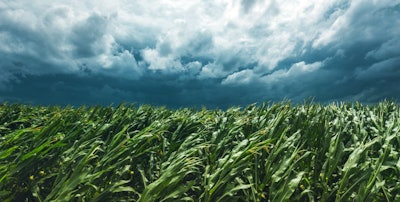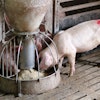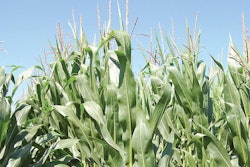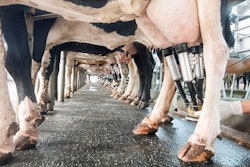
Weather conditions can impact crop yields, animal feed quality and livestock health
Climate change could be partially to blame for this year’s difficult weather conditions at planting and harvest in the United States, and those conditions contribute to less-than-ideal crop conditions, which could have detrimental effects on animal health.
In 2019, U.S. crop farmers have experienced many weather-related challenges, during planting and now at harvest, which have resulted in lost acreage and lower yields.
From a very wet spring across much of the U.S. Corn Belt that prevented planting in some places, to an early snow and freeze that delayed harvest in the Northern Corn Belt, this year has been unique, to say the least.
Read more about climate change and animal feed in the November issue of Feed Strategy magazine.
“I don’t deny by any means that we’ve had a very difficult year, as evidenced by some of the extreme conditions,” said Joseph Kerns, president of Kerns and Associates.
“We’ve never been here before, with the amount of abandoned acres that we have this year from a physical standpoint … as well as percentage of (acreage) not planted,” he said. “Springtime difficulties that we experienced across the entire Midwest were very pronounced and very widespread.”
Crop quality, yields
And these poor conditions extend to the qualities of the crop itself.
“What is obvious to everyone is we have a very poor crop — it’s still very wet,” said Richard Brock, president of Brock Associates. “Corn yields are going to be down significantly from a year ago. We would guess about 11 bushels per acre.”
However, Brock said, the effects of the lower yields will not affect corn prices accordingly.
“To benefit the livestock industry, we’ve come into this year with such a large carryover, the impact on prices is going to be negligible,” he said. “We think the livestock industry is going to pay, on average, maybe 30 cents per bushel more for corn this year than they did last year. But, looking at the big picture, that’s a pretty small increase.”
Soybeans, on the other hand, will be affected more by this year’s weather.
“The real risk weather-wise for the livestock industry is going to be in the soybean/soybean meal market because that crop is so far behind and it’s been impacted by freeze from (mid-October) pretty severely,” Brock said. “As the later soybeans are harvested, they’re the ones that were planted last and are farthest behind in maturity and most susceptible to yield loss.”
Weather trends
But are this year’s conditions just a fluke or part of a trend?
“The 30-year trend is, we are warming up across some of the marginal areas of the northern Corn Belt and the Corn Belt continues to move to the west and to the north,” Kerns said. “From a meteorological standpoint, the most pronounced agronomic trend that we’ve seen is pushback of the first frost date.”
Brock isn’t so sure: “I don’t think our weather volatility, from what I can see, is any more than it was 20 years ago. In the central Corn Belt, we’ve had some issues. Have we ever seen this much water in one year? I don’t think so. This could be a record-setting trend for rainfall in the Midwest, but is that caused (by) cycle changes in worldwide weather? … I don’t know.”
However, Brock said, efficiencies and productivity will help the animal feed industry weather the storm.
“The fortunate thing for the feed industry is we’re still overproducing everywhere. Even with livestock numbers up considerably this year, feed conversions are better than they’ve ever been,” he said. “We’re using less feed with more hogs and chickens than we did in the previous three years. Usage is not going up.”
Effects on animal feed
So, how has all this weather volatility affected crop and feed conditions?
This year’s conditions have “ … led to some early disease issues and then some toxicity issues that have arisen because of that flip from wet to dry to wet,” said Dennis Todey, director of the U.S. Department of Agriculture’s Midwest Climate Hub in Ames, Iowa.
“If you look at the trends in certain places in the Midwest, we are getting drier in the middle of summer and … having some higher atmospheric demand on crops, which then leads to some additional stress because of high atmospheric demand,” meaning the crops use more water during the warm, dry days.
“Overall, because of weather conditions generally, we are seeing an increase in disease pressures on crops, so some of the mycotoxins are going to be involved here,” Todey said.
Mycotoxin development, risks to animal health
According to Raj Murugesan, technical officer at Biomin America Inc., “the impact on climate change to mycotoxin development depends on both the climate effect (hotter seasons, drier conditions, flooding, warmer or colder winters, pest pressure changes) and the mycotoxin itself.”
For example, aflatoxins (AFLA) and fusarium varieties thrive in hot, wet weather, while deoxynivalenol (DON) and zereleanone (ZEN) are associated with cooler, more temperate weather.
This year, he said, the general prediction is an increase in fusarium risk due to higher average temperatures and a greater risk of DON and ZEN in areas where harvest has been delayed, as well as a higher AFLA risk in some of the hotter areas of the South.
Increased mycotoxin occurrence can have an adverse effect on animal health.
“There are definitely significant impacts that climate and extreme climate events can have on animal health,” Murugesan said.
According to the report, “Impact of climate change on animal health and welfare,” which appeared in the journal Animal Frontiers in January, climate change is expected to have an “overwhelming negative effect on livestock health and welfare.”
“The direct effects of climate change on health may be due primarily to increased temperatures and frequency and intensity of heat waves,” the report said. “Heat stress conditions as a result of global warming, high air temperatures and higher frequency of extreme weather events and droughts may negatively affect animal health and welfare.”
These effects may take place as direct effects, such as heat stress, metabolic disorders, oxidative stress, immune suppression or death, as well as indirect effects, including insect-borne diseases, parasites and mycotoxin production.
“Mycotoxins may have a negative effect on specific tissues and organs such as liver, kidney, oral and gastric mucosa, brain or reproductive tract,” the report said.
Murugesan said there are ways to combat these negative effects, such as “integrated pest management, robust crop selection, optimal fungicide application, feed ingredient selection, robust monitoring programs, producer and veterinary education to understand the ways that mycotoxins impact and risk mitigation programs.”
In an October video from Neogen Corp., Alltech’s John Winchell echoed the need for monitoring and testing for mycotoxins in animal feed.
“We need to be a lot more proactive, in my opinion, than reactive, especially when it comes to issues with food safety and animal safety,” he said.











